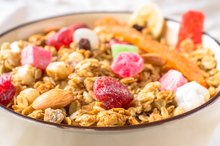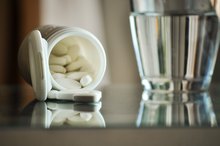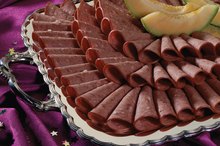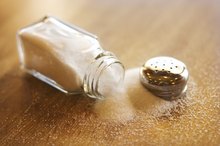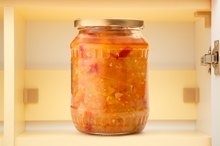What does fact checked mean?
At Healthfully, we strive to deliver objective content that is accurate and up-to-date. Our team periodically reviews articles in order to ensure content quality. The sources cited below consist of evidence from peer-reviewed journals, prominent medical organizations, academic associations, and government data.
The information contained on this site is for informational purposes only, and should not be used as a substitute for the advice of a professional health care provider. Please check with the appropriate physician regarding health questions and concerns. Although we strive to deliver accurate and up-to-date information, no guarantee to that effect is made.
Chemicals in Cheetos
Crunchy, cheesy Cheetos are a favorite all-American snack 1. They also come with a laundry list of both natural and artificial ingredients. If you are a Cheetos fan, it is wise to be aware of what they are made of so you can be more involved in what you are putting into your body. This knowledge can then help you weigh your preference for the snack against the potential health risks that some of the chemical ingredients may pose.
Vitamins and Nutrients
Cheetos contain several natural vitamins and nutrients that are completely safe and actually healthful to consume. Ferrous sulfate is an essential type of iron mineral used for coloring food and as a supplement to treat iron deficiency anemia. Niacin is the vitamin B-3 and is sometimes used in vitamin supplements and to lower cholesterol and triglycerides in your blood, to lower the risk of heart attack and to treat coronary heart disease. Thiamine mononitrate is the vitamin B-1, which adds small amounts of nitrate to foods. Riboflavin is the vitamin B-2, which is crucial in maintaining body tissues and activating enzymes. Folic acid is the vitamin B-9, which helps the body produce and maintain new cells and inhibits cancer by preventing dangerous DNA changes in cells.
- Cheetos contain several natural vitamins and nutrients that are completely safe and actually healthful to consume.
- Riboflavin is the vitamin B-2, which is crucial in maintaining body tissues and activating enzymes.
Acids
Foods That Contain EDTA
Learn More
The acids in Cheetos are found in virtually all living organisms, are safe to consume and help give the snack its unique flavor. Lactic acid helps balance the acidity in cheese making, adds tartness to frozen desserts and carbonated fruit-flavored drinks and inhibits spoilage in Spanish-type olives. Citric acid is a versatile, widely used and cheap chelating agent that is used for tart food flavoring and as an antioxidant.
Sodium-Based Chemicals
The forms of sodium in Cheetos are best consumed with caution, especially for people with certain health conditions. Basic salt, or sodium chloride, is used as a flavoring and preservative in the snack. High levels of salt are linked with harmful risks, such as increased blood pressure and higher risk of heart attack and stroke. The sodium content of Cheetos is 250 milligrams per 1-ounce serving, which is more than 10 percent of the recommended intake of 2,300 milligrams for healthy adults, or the 1,500 milligrams recommended if you suffer from hypertension. The U.S. Food and Drug Administration, or FDA, has claimed moderate amounts of salt as "generally recognized as safe." Monosodium glutamate, or MSG, is an amino acid that is used as a flavor enhancer in foods, and large amounts have been shown to destroy nerve cells in mice and occasionally cause:
- headaches
- burning sensations
- wheezing
- other symptoms in humans
Disodium phosphate is the sodium salt of orthophosphoric acid and is used as an antioxidant synergist, stabilizer and acid buffering agent in foods. It also helps emulsify pasteurized processed cheese and keeps powdered milk from clumping.
- The forms of sodium in Cheetos are best consumed with caution, especially for people with certain health conditions.
- The sodium content of Cheetos is 250 milligrams per 1-ounce serving, which is more than 10 percent of the recommended intake of 2,300 milligrams for healthy adults, or the 1,500 milligrams recommended if you suffer from hypertension.
Maltodextrin
Sodium Erythorbate Side Effects
Learn More
Maltodextrin consists of short chains of starchy glucose molecules and is safe to consume. It enhances texture in foods and is easily digested and absorbed by the body unless it is "resistant maltodextrin," which is used as a dietary fiber that cannot be broken down and may help lower blood sugar levels.
Artificial Coloring and Flavoring
One of the artificial colorings used in Cheetos is Yellow 6, the third most widely used dye, according to Center for Science in the Public Interest 2. Try avoiding consumption as the dye has caused adrenal gland and kidney tumors in animal tests and contains small amounts of carcinogens. The FDA states that it poses no significant cancer risks to humans but may cause occasional severe hypersensitivity reactions. To protect flavor trade secrets, food companies like Frito Lay are not required to list the ingredients in their products' artificial flavors. These flavors are a blend of natural and synthetic chemicals and may contain dozens of ingredients that range from safe to notably risky to consume.
- One of the artificial colorings used in Cheetos is Yellow 6, the third most widely used dye, according to Center for Science in the Public Interest 2.
- Try avoiding consumption as the dye has caused adrenal gland and kidney tumors in animal tests and contains small amounts of carcinogens.
Related Articles
References
Writer Bio
Serene Leavitt has been researching, writing and editing since 2007. She created original content for "Ultimate Adventures: A Rough Guide to Adventure Travel" and edited for The Little Biggy Corporation, an online review database. Leavitt is a self-taught expert in nutrition, fitness and health. She holds a Bachelor of Arts in English and a minor in editing from Brigham Young University.
